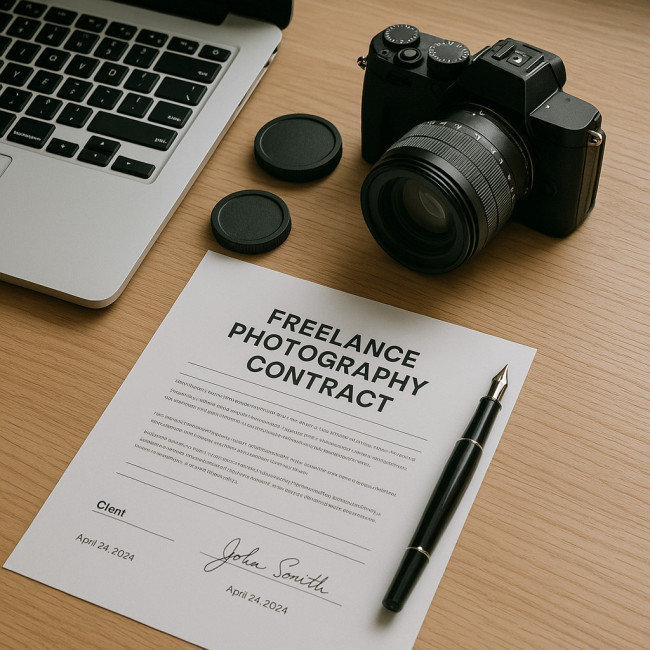Freelance photo contracts: clauses that protect creativity and revenue alike
A clear, well-structured contract lets you shoot with confidence, defend your artistic vision and secure prompt payment. Discover the key clauses every freelance photographer should negotiate, practical talking points for client meetings and tips to keep relationships thriving long after the shutter clicks.
Why a written contract is non-negotiable
Verbal agreements break under the weight of misunderstandings, changing briefs or staff turnover on the client's side. A concise written contract:
- Defines creative expectations so revisions do not spiral.
- Locks in fees, usage rights and deadlines—avoiding payment dramas.
- Preserves your intellectual property for future licensing revenue.
- Protects both parties from liability claims and data leaks.
Clients increasingly search collaboration-ready photographers who demonstrate solid business practice. A robust contract signals professionalism before you even unpack your gear.
Core clauses to bullet-proof your photography contract

The following section distills the legal DNA of every successful assignment into eight plain-English clauses you can copy-paste into your own template. Think of it as the security shutter you pull down over your creative storefront at night: it keeps out vague briefs, mission creep and late-night “quick fixes” that mutate into unpaid overtime. By clarifying deliverables, rights and responsibilities up front, you stop tiny ambiguities snowballing into expensive conflicts and you free up mental bandwidth to chase light, not invoices. Bookmark it, tweak the numbers and walk into your next pre-production meeting sounding like both an artist and a CFO rolled into one.
1. Scope of work & deliverables
Detail shoot dates, locations, required shots and the exact number of edited files. Include formats and resolution. This eliminates “could you also…” requests after the fact.
2. Usage rights & licensing
State how, where and for how long the client may use the images. Common models:
| Licence type | Duration | Territory | Typical fee multiplier* |
|---|---|---|---|
| Web-only, non-exclusive | 1 year | Single country | 1× day rate |
| Print & digital, exclusivity | 3 years | Regional | 2–3× day rate |
| Global, perpetual | Unlimited | Worldwide | 5×+ day rate |
*Multipliers vary by niche. See our value-based licensing guide for deeper benchmarks.
3. Payment schedule & late-fee triggers
Industry norm: 50 % on booking, 50 % on final delivery. Add a precise due date (e.g., “net 15” after invoice) and a late-payment interest rate compliant with local law.
4. Kill fees & cancellation terms
Weather, venue issues or pandemics happen. Charge a sliding scale:
- More than 14 days' notice – full refund minus admin fee.
- 7–14 days – 50 % of shoot fee.
- Under 7 days – 100 % of shoot fee plus prepaid expenses.
5. Creative control & retouch rounds
Specify how many rounds of retouch are included (usually one). Extra rounds bill at an hourly rate. Retain the right to refuse edits that compromise ethical standards or image quality.
6. Credits & moral rights
Add a mandatory credit line on all published uses: “© Your Name / Your Studio”. This supports discovery via backlinks and social tags. You may waive but charge more.
7. Liability & insurance
Limit your liability to the amount paid under the contract. Confirm you carry public liability and equipment cover, and request the client arranges venue insurance.
8. Confidentiality & NDAs
For product launches or celebrity shoots, attach a mutual NDA. Ensure it lists what you can still display in your portfolio once the embargo lifts.
Negotiation tactics that keep doors open
- Lead with the brief, not the clause. Align on creative goals before discussing legal language.
- Offer tiered rights. If the budget is tight, license limited rights now and upsell broader usage later.
- Reference industry standards. Point to trade-body templates or a recent retainer agreement you executed successfully.
- Trade concessions. A faster turnaround may justify a rush fee discount; wider credit placement can balance a lower day rate.
- Keep edits in Google Docs. Collaborative redlining speeds approval and leaves an audit trail.
Red flags—walk away if you read these
- “Work for hire” without a premium fee (you surrender all rights forever).
- No kill-fee clause—even large brands sometimes cancel last minute.
- Payment on client publication: your income should never hinge on their marketing calendar.
- Uncapped indemnity: you could be liable for amounts far exceeding your fee.
Signing timeline: from enquiry to delivered files
- Initial call → send rate card & summary proposal within 24 h.
- Negotiate scopes & rights → lock contract in 3-5 days.
- Collect deposit → reserve shoot date on payment confirmation.
- Shoot day → gather backup imagery for potential upsell.
- Proof gallery → client selects finals within 7 days.
- Deliver retouched files → issue final invoice, due net 15.
- Follow-up → request credit links and discuss add-on licences.
Delegating part of this workflow to a trusted assistant? Review the assistant roles checklist to ensure your helper's duties are equally well documented.
Quick quiz: Test your contract IQ
FAQ
- Can I reuse images in my portfolio if the client bought exclusive rights?
- Yes, if the contract includes a self-promotion carve-out. Ask for “portfolio use” in all exclusivity deals.
- Should I charge VAT or sales tax on kill fees?
- Usually yes, because it compensates for services already performed. Confirm with your accountant.
- How do I price perpetual global licences?
- Start at 5 times your combined shoot and post-production fee, then adjust for client size and distribution scale.
- What if the client edits my photos without approval?
- Include a “no alteration without written consent” clause and specify penalties, such as revocation of usage rights.
- Is an email thread legally binding?
- Often, but enforcement is harder. A signed PDF or e-signature platform provides clearer evidence and reduces disputes.
Ready to lock down your next brief? Use these clauses as your baseline, adapt them to each project and keep your creative energy focused on what matters—making images that clients can't wait to publish and pay for.
—
Need a deeper dive into pricing strategy? Bookmark our guide on directory-based client discovery next.











